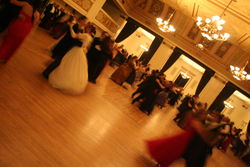Partner dance
Music Sound
Partner dance
 Partner dance.
Partner dance.Partner dances are the
dances whose
basic choreography involves coordinated dancing of two partners, as opposed to
individuals
dancing alone or individually in a non-coordinated manner, and as opposed to
groups of
people dancing simultaneously in a coordinated manner.
Dance partners stay together for the duration of the dance and, most often,
dance independently of other couples dancing at the same time, if any.
Although this kind of dancing can be seen, for instance, in ballet, this term
is usually applied to various forms of
social
dance and related forms:
ballroom dance,
folk dance,
etc.
Partner dance may be a basis of a
formation dance, a
round
dance, a
square
dance or a
sequence dance. These are kinds of
group
dance where the dancers form couples and dance either the same
pre-choreographed or called routines or routines within a common choreographyŚ
routines that control both how each couple dances together and how each couple
moves in accord with other couples. In square dance one will often change
partners during the course of a dance, in which case one distinguishes between
the "original partner" and a "situational partner".
In many partner dances, one, typically a man, is the leader; the
other, typically a woman, is the follower. As a rule, they maintain
connection with each other. In some dances the connection is loose and called
dance handhold. In other dances the connection involves body contact. In the
latter case the connection imposes significant restrictions on relative body
positions during the dance and hence it is often called dance frame. It is also
said that each partner has his own dance frame. Although the handhold connection
poses almost no restriction on body positions, it is quite helpful that the
partners are aware of their dance frames, since this is instrumental in leading
and following.
In situations where the number of men and women are unequal, women tend to feel
more comfortable than men when dancing with other members of the same
gender. However, in real-world situations such as in salsa clubs, two men
dancing together is practically never seen, and probably strongly frowned upon.
It is believed that due to the macho Latin culture in salsa clubs, two men would
never dance together and risk their "image." At partner dance events held at
dance studios the situation may well be different as the context may make it
clear that the two men are simply practicing the dance moves they're learning. Two women dancing together in salsa clubs is common,
even cheered on by the male bystanders as some sort of entertainment.
In
promenade-style partner dancing there is no leader or follower, and the
couple dance side-by-side maintaining a connection with each other through a
promenade handhold. The man dances traditionally to the left of the woman.
Some peoples have folk partner dances, where partners do not have any body
contact at all, but there is still a kind of "call-response" interaction.
Nowadays, the most popular form of partner dancing among youth is "slow
dancing" (for instance, dancing to ballads; see slow jam),
and how close the partners get is up to them. In the "hug-and-sway" version of
slow dancing, the man usually puts his arms around the female's waist, while the
female puts her arm on the man's shoulders.
 Gaskell Ball
Gaskell Ball
 Gaskell Ball
Gaskell Ball
Double partner dance
This kind of dance involves dancing of three persons together: one man with
two women or one woman with two men. In
social
dancing, double partnering is of choice when a significant demographic
disproportion happens between the two sexes. For example, this happens during
wars: in army there is lack of women, while among civilians able dancers are
mostly women, especially during enormous wars such as
WWII.
Today (1980-2004), double partner dance is often performed in Hustle, Salsa and
Swing dance communities, experienced leaders leading two followers.
There are a number of folk dances that feature this setup. Among these are
the Russian
Troika and the Polish Trojak folk dances, where a man dances with two women. A
Cajun dance with the name Troika is also known.
Home | Up | Ballroom dance | Latin dance | Novelty and fad dances | Partner dance | Square dance | Swing dance
Music Sound, v. 2.0, by MultiMedia
This guide is licensed under the GNU
Free Documentation License. It uses material from the Wikipedia.
|







